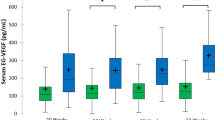Abstract
Background
Spontaneous preterm birth is challenging to prevent. Only few predictors of spontaneous preterm birth risk have been reported, and further studies on spontaneous preterm birth should be conducted to reduce the number of cases.
Purpose
The aim of the present study was to explore if anti-β2-glycoprotein I antibody can be used to predict the risk of spontaneous preterm birth, and its clinical value in assessing the risk of spontaneous preterm birth.
Methods
A total of 302 pregnant women who had delivered between January 2019 and December 2021 were enrolled into the study. The subjects were assigned to the case group (28–33+6 weeks, n = 41; 34–36+6 weeks, n = 96) and control group (37–42 weeks, n = 165) according to the gestational period. The age, body mass index, and gestational days of the two groups were recorded. Blood samples were collected and the levels of anti-β2-glycoprotein I antibody, white blood cell, red blood cell, hemoglobin, aspartate aminotransferase, alanine aminotransferase, alkaline phosphatase, urea, creatinine, glucose, triglyceride, and total cholesterol were evaluated. Pregnant women diagnosed with sPTB that met the standards after evaluation by the clinician were included in the study.
Results
The level of anti-β2-glycoprotein I antibody was higher in case group than in the control group [(23.93 ± 8.11)Ru/mL vs (11.50 ± 5.33)Ru/mL]. The results showed that anti-β2-glycoprotein I antibody was an independent risk factor for spontaneous preterm birth. The area under ROC curve of anti-β2-glycoprotein I antibody to predict spontaneous preterm birth was 0.8875 (95%CI 0.8443–0.9307). The highest predicted value of anti-β2-glycoprotein I antibody was 16.49Ru/ml.
Conclusion
Anti-β2-glycoprotein I antibody has a high clinical significance and can be used by clinicians to evaluate the probability of spontaneous preterm birth.


Similar content being viewed by others
Availability of data and materials
The datasets supporting the conclusion of this article are included within the article.
References
Camunas-Soler J et al (2022) Predictive RNA profiles for early and very early spontaneous preterm birth. Am J Obstet Gynecol. https://doi.org/10.1016/j.ajog.2022.04.002
Jaiman S et al (2022) The role of the placenta in spontaneous preterm labor and delivery with intact membranes. J Perinat Med. https://doi.org/10.1515/jpm-2021-0681
Masters HR et al (2022) Time required to complete transvaginal cervical length in women receiving universal cervical length screening for preterm birth prevention. J Matern Fetal Neonatal Med. https://doi.org/10.1080/14767058.2020.1811666
Eva N, Hamulyák et al (2020) Aspirin or heparin or both for improving pregnancy outcomes in women with persistent antiphospholipid antibodies and recurrent pregnancy loss. https://doi.org/10.1002/14651858.CD012852.pub2
Kervinen K et al (2022) Parity and gestational age are associated with vaginal microbiota composition in term and late term pregnancies. EBioMedicine. https://doi.org/10.1016/j.ebiom.2022.104107
Al-Shaikh GK et al (2017) Grand multiparity and the possible risk of adverse maternal and neonatal outcomes: a dilemma to be deciphered. BMC Pregnancy Childbirth. https://doi.org/10.1186/s12884-017-1508-0
Saccone G et al (2017) Antiphospholipid antibody profile based obstetric outcomes of primary antiphospholipid syndrome: the PREGNANTS study. Am J Obstet Gynecol. https://doi.org/10.1016/j.ajog.2017.01.026
Sovio U et al (2021) Slowing of fetal growth and elevated maternal serum sFLT1:PlGF are associated with early term spontaneous labor. Am J Obstet Gynecol. https://doi.org/10.1016/j.ajog.2021.04.232
Vanoverschelde L et al (2019) Influence of anticardiolipin and anti-β2 glycoprotein I antibody cutoff values on antiphospholipid syndrome classification. Res Pract Thromb Haemost. https://doi.org/10.1002/rth2.12207
Burchard J et al (2022) Better estimation of spontaneous preterm birth prediction performance through improved gestational age dating. J Clin Med. https://doi.org/10.3390/jcm11102885
American College of Obstetricians and Gynecologists (2012) ACOG practice bulletin No. 127: Management of preterm labor. Obstet Gynecol. https://doi.org/10.1097/AOG.0b013e31825af2f0
Laura G et al (2020) Controversies in the prevention of spontaneous preterm birth in asymptomatic women: an evidence summary and expert opinion. BJOG. https://doi.org/10.1111/1471-0528.16544
Sobhani NC et al (2020) Prolonged second stage of labor and risk of subsequent spontaneous preterm birth. Am J Obstet Gynecol MFM. https://doi.org/10.1016/j.ajogmf
Peng C-C et al (2018) Intrauterine inflammation, infection, or both (Triple I): A new concept for chorioamnionitis. Pediatr Neonatol. https://doi.org/10.1016/j.pedneo.2017.09.001
Devreese KM et al (2017) A multicenter study to assess the reproducibility of anti-phospholipid antibody results produced by an automated system. J Thromb Haemost. https://doi.org/10.1111/jth.13560
Tarca AL et al (2021) Crowdsourcing assessment of maternal blood multi-omics for predicting gestational age and preterm birth. Cell Rep Med. https://doi.org/10.1016/j.xcrm.2021.100323
Mahmud SA et al (2022) Non-criteria antiphospholipid antibodies and pediatric rheumatic disease: a case series. Pediatr Rheumatol Online J. https://doi.org/10.1186/s12969-022-00732-4
Melayah S et al (2022) Frequency of serological markers of rheumatoid arthritis in patients with IgA anti-β2 glycoprotein I antibodies. J Clin Lab Anal. https://doi.org/10.1002/jcla.24537
Funding
This work was supported by the Zhangjiakou Key R&D Program Project (2021111D).
Author information
Authors and Affiliations
Contributions
LZ contributed to conception and design, and drafting and revision of the paper for important intellectual content. XL contributed to statistical analysis, and drafting and revision of the paper for important intellectual content. BZ contributed to conception and design, and drafting and revision of the paper for important intellectual content. XS contributed to drafting and revision of the paper for important intellectual content.
Corresponding author
Ethics declarations
Conflict of interest statement
The authors declare that they have no known competing financial interests or personal relationships that could have appeared to influence the work reported in this paper.
Ethics approval and consent to participate
All procedures were approved by the First Affiliated Hospital of Hebei North University (Approval No.: K2020162).
Consent for publication
Not applicable.
Additional information
Publisher's Note
Springer Nature remains neutral with regard to jurisdictional claims in published maps and institutional affiliations.
Rights and permissions
Springer Nature or its licensor (e.g. a society or other partner) holds exclusive rights to this article under a publishing agreement with the author(s) or other rightsholder(s); author self-archiving of the accepted manuscript version of this article is solely governed by the terms of such publishing agreement and applicable law.
About this article
Cite this article
Zuo, L., Li, X., Zhang, B. et al. Anti-β2-glycoprotein I antibody maybe a novel biomarker of spontaneous preterm birth. Arch Gynecol Obstet 307, 1091–1095 (2023). https://doi.org/10.1007/s00404-022-06892-8
Received:
Accepted:
Published:
Issue Date:
DOI: https://doi.org/10.1007/s00404-022-06892-8




